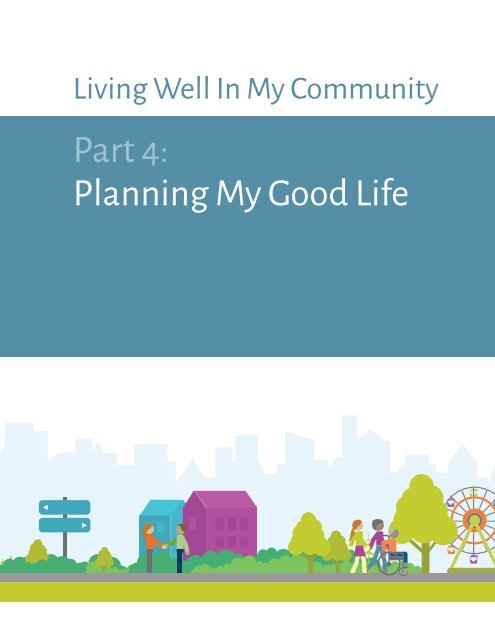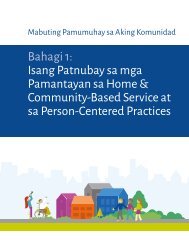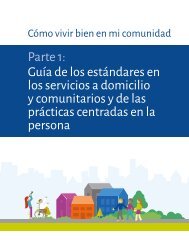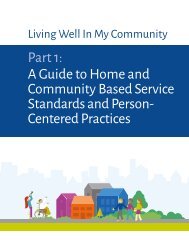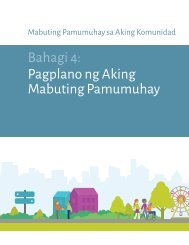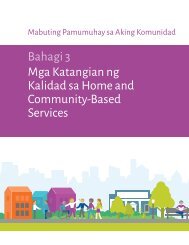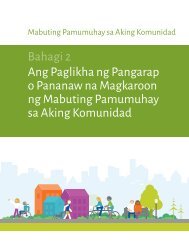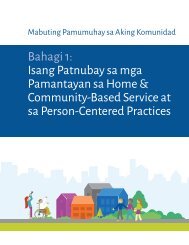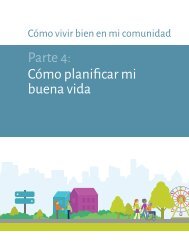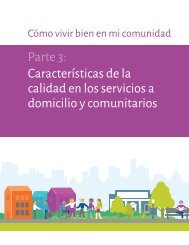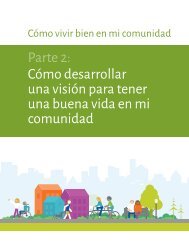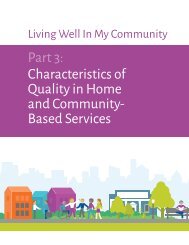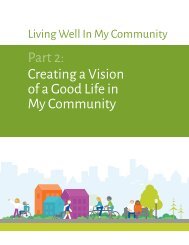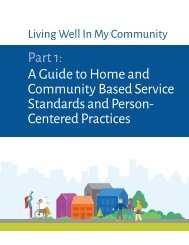Living Well In My Community Part 4 - Planning My Good Life
Create successful ePaper yourself
Turn your PDF publications into a flip-book with our unique Google optimized e-Paper software.
<strong>Living</strong> <strong>Well</strong> <strong>In</strong> <strong>My</strong> <strong>Community</strong><br />
<strong>Part</strong> 4:<br />
<strong>Planning</strong> <strong>My</strong> <strong>Good</strong> <strong>Life</strong>
How to use <strong>Living</strong> <strong>Well</strong> <strong>In</strong> <strong>My</strong><br />
<strong>Community</strong><br />
Feel free to download this guide to use and share with<br />
others. <strong>Living</strong> <strong>Well</strong> <strong>In</strong> <strong>My</strong> <strong>Community</strong> was created to<br />
help people with disabilities and service providers<br />
better understand the rights and roles for living well<br />
in the community. <strong>Part</strong> 1 explains what the Home and<br />
<strong>Community</strong>-Based Services Rule is and how it can help<br />
people with disabilities to live in the community like<br />
other people without disabilities.<br />
<strong>In</strong> <strong>Part</strong> 2, resources from Charting the <strong>Life</strong> Course<br />
can be used to create a vision of a good life in the<br />
community. <strong>Part</strong> 3 describes each characteristic of<br />
quality home and community-based services with<br />
some reflective questions to assess progress and<br />
areas for continued development. Examples of some<br />
person-centered approaches are introduced to help<br />
individuals with disabilities and providers move in<br />
the direction of a person’s vision of a good life. The<br />
person-centered approaches described in <strong>Living</strong> <strong>Well</strong><br />
<strong>In</strong> <strong>My</strong> <strong>Community</strong> will also be helpful to providers in<br />
meeting the home and community-based settings<br />
requirements. <strong>Part</strong> 4 has useful tips for working with<br />
a planning team to support a vision of a good life<br />
through person-centered planning, as well as an array<br />
of resources for more information.<br />
HCBS Peer <strong>Part</strong>ners Project Grant<br />
The workbook is funded by a grant from the California<br />
Department of Developmental Services. UCP WORK,<br />
<strong>In</strong>c. is the lead agency, representing a regional project<br />
reflecting efforts of multiple providers that support<br />
individuals and families in the Tri-Counties Regional<br />
Center catchment area. This includes UCP-LA and Villa<br />
Esperanza in Ventura County, UCP WORK, <strong>In</strong>c., CPES/<br />
Novelles, and Devereux in Santa Barbara and San Luis<br />
Obispo Counties. An ad hoc subcommittee of the TCRC<br />
Vendor Advisory Committee, comprised of service<br />
providers, regional center staff, and representation<br />
from the State Council on Developmental Disabilities<br />
(SCDD), implemented a survey of regional service<br />
providers. Upon reviewing results, the survey<br />
revealed a gap in getting HCBS information as well as<br />
Person-Centered Thinking resources to providers in<br />
outlying areas operating a small business which serve<br />
individuals and families.<br />
The impetus for the efforts of the grant project is in<br />
aiding providers to understand how to meet the new<br />
HCBS Waiver <strong>Community</strong> Standards. The greater<br />
goal of the standards and this grant project is to<br />
support persons with developmental disabilities to<br />
have better lives, not just better paper. We endeavor<br />
to give the people we support more control over their<br />
services, receiving what is important to them: services<br />
supporting their own vision for the future and what is<br />
important for to be healthy, safe valued, members of<br />
their community.<br />
Acknowledgments<br />
Thank you to the many contributors who<br />
helped in creating this guide<br />
HCBS Peer <strong>Part</strong>ner Advisory Committee<br />
Dave Mulvey, HCBS Peer <strong>Part</strong>ners Project<br />
Coordinator<br />
Diva Johnson, Tri-Counties Regional Center<br />
Harry Bruell, PathPoint<br />
Judy Linares and Kathy Webb, UCP Work <strong>In</strong>c.<br />
Mark O’Keefe, Tri-Counties Regional Center<br />
Mary Beth Lepkowsky, HSAUSA<br />
Michele Ferrall, CPES/Novelles<br />
Nikisa Simmons UCP-LA<br />
Tina Calderaro-Mendoza, Tri-Counties<br />
Regional Center<br />
<strong>Living</strong> <strong>Well</strong> <strong>In</strong> <strong>My</strong> <strong>Community</strong> was funded<br />
by a grant from the California Department of<br />
Developmental Services and includes principles<br />
and concepts developed by and used here with<br />
permission from The Learning <strong>Community</strong> for<br />
Person-Centered Practices. http://tlcpcp.com/<br />
Stories and examples were contributed by<br />
Sue Goss, Diva Johnson, Rebecca Martinez,<br />
David Mulvey, Valerie Nix, Michael Kaszycki,<br />
Derek Smith and Mary Beth Lepkowsky.<br />
Others were generous in giving permission to<br />
share a variety of person-centered resources.<br />
Helen Sanderson Associates USA<br />
https://helensandersonassociates.com<br />
John O’Brien and Beth Mount<br />
http://www.inclusion.com/<br />
bkmakeadifference.html<br />
Line Plourde-Kelly Kapuskasing & District<br />
Association for <strong>Community</strong> <strong>Living</strong> (KDACL)<br />
http://www.kdacl.com<br />
Charting the <strong>Life</strong>course<br />
https://www.lifecoursetools.com<br />
Editors: Mary Beth Lepkowsky, Dave Mulvey,<br />
Eugene Baldwin<br />
Translations: <strong>In</strong>line Translation Services.<br />
Design: Julie Barclay<br />
May 2020<br />
Contents<br />
<strong>Part</strong> 4: <strong>Planning</strong> <strong>My</strong> <strong>Good</strong> <strong>Life</strong><br />
Working With a <strong>Planning</strong> Team........................ 4.5<br />
• Skill: Relationship Map.................................. 4.5<br />
Person-Centered <strong>Planning</strong>............................... 4.11<br />
• Skill: What’s Working / Not Working........... 4.11<br />
<strong>Community</strong> Building Checklist........................ 4.15<br />
Resources...........................................................4.19<br />
4.2 <strong>Living</strong> <strong>Well</strong> <strong>In</strong> <strong>My</strong> <strong>Community</strong>
<strong>Planning</strong> <strong>My</strong> <strong>Good</strong> <strong>Life</strong><br />
Person-Centered <strong>Planning</strong><br />
“Person-centered planning grew out of<br />
a passionate concern to support people<br />
with developmental disabilities in<br />
discovering and contributing their gifts.”<br />
Connie Lyle O’Brien and John O’Brien<br />
Home and community-based services<br />
requirements include each individual having<br />
a person-centered service plan that describes<br />
their long-term services and support needs<br />
for living well in the community.<br />
Medicaid will cover home and community-based<br />
services only when a person-centered service<br />
plan (service plan) is created that addresses the<br />
person’s long-term care needs as an alternative<br />
to institutionalization. Person-centered thinking<br />
skills introduced throughout <strong>Living</strong> <strong>Well</strong> <strong>In</strong> <strong>My</strong><br />
<strong>Community</strong>, illustrate examples of people with<br />
disabilities having more positive choice and<br />
control in their lives. The skills offer multiple<br />
ways to have conversations to learn what is<br />
important to the person to be happy, content and<br />
fulfilled, and what is important for the person to<br />
remain healthy, safe and valued by others. The<br />
information gathered from those conversations<br />
can inform the person-centered planning process.<br />
Person-centered planning is a way of listening to<br />
choices people make about the way they want<br />
to live…and making it happen. This approach to<br />
planning grew out of a passionate concern to<br />
support people with developmental disabilities<br />
in discovering and contributing their gifts.<br />
There are many different methods of personcentered<br />
planning including PATH, Maps,<br />
Circles of Support, Personal Futures <strong>Planning</strong>,<br />
Essential <strong>Life</strong>style <strong>Planning</strong>, Person-Centered<br />
Reviews, Liberty Plans, to name a few. A<br />
common element to all forms of personcentered<br />
planning is getting to know the<br />
person being supported by listening to their<br />
words and actions and listening to those<br />
who know and love the individual. The<br />
person-centered thinking and planning skills<br />
introduced throughout <strong>Living</strong> <strong>Well</strong> <strong>In</strong> <strong>My</strong><br />
<strong>Community</strong> help to answer the questions:<br />
• Who is this person?<br />
• What gifts and capacities do they bring?<br />
• What community opportunities will enable<br />
this person to pursue his or her hopes and<br />
dreams in a positive and successful way?<br />
Through the person-centered planning<br />
process, the person receiving supports will:<br />
• Identify their hopes and dreams (the Vision<br />
Tool in <strong>Part</strong> 2 can help with this).<br />
• Identify what they like and are good at.<br />
• Identify and set meaningful goals for living<br />
well in their community.<br />
• Choose who will provide services and<br />
supports to help them meet their goals.<br />
<strong>Planning</strong> will help the person think about<br />
things like:<br />
• Where to live<br />
• Who to live with<br />
• Where to work or go to school<br />
• Who to have for friends<br />
• What to do for fun<br />
• What to do in the future<br />
• What services and supports the person<br />
wants and needs<br />
<strong>Planning</strong> <strong>My</strong> <strong>Good</strong> <strong>Life</strong> 4.3
<strong>Planning</strong> <strong>My</strong> <strong>Good</strong> <strong>Life</strong><br />
Person-centered planning is an ongoing<br />
process.<br />
• It does not happen just once.<br />
• The person can share their ideas in<br />
whatever way they communicate.<br />
• The person with a disability may choose<br />
other people they want to have present.<br />
• Person-centered planning can look<br />
different for each person, and that’s okay.<br />
The <strong>Planning</strong> Team<br />
A person receiving home and communitybased<br />
services might bring together a team<br />
of supporters who know and care about<br />
them to help with the planning process and<br />
participate as members of the “<strong>Planning</strong><br />
Team.” The purpose of the <strong>Planning</strong> Team is<br />
to identify opportunities for the person with<br />
a disability to develop personal relationships,<br />
participate in the community, increase control<br />
over their own lives, and develop the skills<br />
and abilities needed to achieve their goals.<br />
Successful person-centered planning depends<br />
on the commitment of a team of supporters<br />
who care about the person. These helpers take<br />
action to make sure that the actions discussed<br />
in planning meetings are implemented.<br />
Who might be invited to be part of the<br />
<strong>Planning</strong> Team?<br />
• The person receiving home and<br />
community-based services is the most<br />
important member.<br />
• Parents and Legal Guardians.<br />
• Direct support staff and other people who<br />
know and care about the person receiving<br />
home and community-based services.<br />
• A service coordinator from the Regional<br />
Center who can arrange the services that<br />
are wanted and needed.<br />
• Anyone else the person wants to include.<br />
The <strong>Planning</strong> Team is especially helpful when:<br />
• The person wants to check on progress and<br />
explore what is working and what is not<br />
working.<br />
• The person wants to make a change to their<br />
person-centered plan or IPP (<strong>In</strong>dividual<br />
Program Plan).<br />
• The person would like help in thinking<br />
about some new possibilities.<br />
• The person feels they are not being<br />
understood or listened to by current<br />
providers or other supporters.<br />
Getting Started with Person-<br />
Centered <strong>Planning</strong><br />
The first step in the person-centered<br />
planning process is to think about who are<br />
the important people in a person’s life. Who<br />
are the friends and supporters who can help?<br />
Some people will choose to have a lot of<br />
people in their circle of support. Others will<br />
choose very few, or perhaps no one else to<br />
help them plan. That’s okay. The Relationship<br />
Map is a helpful skill to think this through.<br />
4.4 <strong>Living</strong> <strong>Well</strong> <strong>In</strong> <strong>My</strong> <strong>Community</strong>
how to<br />
do it<br />
Working With a <strong>Planning</strong> Team<br />
SKILL: Relationship map<br />
What it does<br />
It captures who a person<br />
knows, how they know them,<br />
and how these networks and<br />
relationships can help a person<br />
to live the life they choose.<br />
How it helps<br />
It is a way of identifying who is<br />
important to a person, and to<br />
explore any important issues<br />
around those relationships.<br />
It feeds into person-centered<br />
support planning because<br />
it highlights those people<br />
who should be involved in<br />
planning, and helps to discover<br />
which relationships can be<br />
strengthened or supported.<br />
How to use it<br />
1. Map out the important<br />
people in the person’s life.<br />
Emotional closeness<br />
determines where names go<br />
in the relationship map, as<br />
opposed to how close a “blood”<br />
relationship is. The people who<br />
know the person well and care<br />
about them will be added to<br />
the circles that are closer to<br />
the center. This is based on<br />
connectedness and strength of<br />
feelings toward a person, and<br />
not necessarily how much time<br />
they spend with the person.<br />
2. Find out who to listen to.<br />
A Relationship Map gives us ideas about who we should<br />
talk with in order to develop a good picture of what is<br />
important to the person. It doesn’t tell us whom to listen<br />
to. Asking a few questions will help us figure out who has<br />
a genuine relationship with the individual and who has<br />
nothing more than a working relationship. A staff member<br />
wanting to know whom to listen to should ask:<br />
• What do you like about the person?<br />
• What do you admire about the person?<br />
• When’s the last time you had fun together and what did<br />
you do?<br />
People who have a working relationship will have difficulty<br />
answering those questions or may only answer from a<br />
“human service perspective.” For example: What do you like<br />
about the person? “He has good hygiene.”<br />
3. Ask for permission to talk with people listed in<br />
the relationship map. People who have a genuine<br />
relationship will be more likely to talk about the person’s<br />
positive gifts and qualities.<br />
There may be times when you shouldn’t do a Relationship<br />
Map. For example, if someone just experienced a significant<br />
loss of a family member or friend, they may be struggling<br />
with profound feelings of loneliness. On the other hand, it<br />
can help people to see who is there, whom they can count<br />
on, and whom they can trust.<br />
<strong>Planning</strong> <strong>My</strong> <strong>Good</strong> <strong>Life</strong> 4.5
Working With a <strong>Planning</strong> Team<br />
SKILL: Relationship map<br />
SHARING<br />
STORIES<br />
Mike<br />
Mike had recently moved into his own residence with<br />
supported living services that he shared with friends in a<br />
city that was new to him. As a part of his Person- Centered<br />
<strong>Planning</strong> meeting he, his mother and his support team<br />
completed a Relationship Map. His current day program and<br />
supported living staff learned who their counterparts were in<br />
the city where he had previously lived.<br />
Making those connections allowed his current support staff<br />
to share the learning of previous staff on what was important<br />
to and important for Mike, and how to best support him.<br />
The current staff learned of<br />
relatives living near Mike’s new<br />
home that staff could support<br />
Mike to visit. They also learned<br />
about Dewy and Louie, his<br />
mother’s two dogs, who were<br />
very important to Mike and<br />
that Mike missed very much.<br />
Staff arranged for Mike to have<br />
regular visits to a local pet<br />
shelter where he could enjoy<br />
interacting with the dogs there.<br />
Family<br />
Aunt Hildie and<br />
Uncle Stan<br />
People (who support me at<br />
work or school)<br />
Ross,<br />
Jason (day<br />
program<br />
staff)<br />
Dewy and Louie<br />
(my dogs)<br />
Mike<br />
TJ, Carlos<br />
(friends at<br />
program)<br />
Joanne<br />
(mom)<br />
Vickie, Kelly,<br />
Naseem<br />
(SLS staff)<br />
Liliana, Cory<br />
(former SLS staff)<br />
People (whose job is to<br />
support me at home and<br />
other places)<br />
Ned, Caroline (friends from<br />
old neighborhood)<br />
Friends<br />
4.6 <strong>Living</strong> <strong>Well</strong> <strong>In</strong> <strong>My</strong> <strong>Community</strong>
Working With a <strong>Planning</strong> Team<br />
SKILL: Relationship map<br />
Family<br />
People (who support me at<br />
work or school)<br />
People (whose job is to support<br />
me at home and other places)<br />
Friends<br />
<strong>Planning</strong> <strong>My</strong> <strong>Good</strong> <strong>Life</strong> 4.7
Working With a <strong>Planning</strong> Team<br />
Working with a<br />
<strong>Planning</strong> Team<br />
After completing a Relationship<br />
Map, and with a better<br />
understanding of who a person<br />
wants to include on their<br />
planning team, involve those<br />
people to:<br />
• Gather information to create<br />
the person’s life story.<br />
• Explore with the person their<br />
opportunities for community<br />
participation, community<br />
presence, choices and<br />
expression of rights, respect<br />
and competence.<br />
• Prepare a person-centered<br />
description that includes<br />
things the person enjoys<br />
doing and the things that the<br />
person prefers not to do.<br />
• Create a One-Page Profile/<br />
Description to include top<br />
tips about “What others<br />
appreciate about me.” ,<br />
“What’s important to me” and<br />
“How to best support me.”<br />
The One-Page Profile can be<br />
a wonderful introduction of<br />
a person and a great starting<br />
place for a <strong>Planning</strong> Team.<br />
<strong>Planning</strong> Team meetings<br />
A <strong>Planning</strong> Team meeting can be requested whenever the<br />
person wants to create or update their person-centered<br />
plan or work through issues or obstacles. Here is a<br />
summary of what might happen during a person-centered<br />
planning team meeting.<br />
1. The person receiving support will decide on a purpose,<br />
agenda, time and place for meeting. Sometimes, the<br />
person may invite others to help with these logistics.<br />
2. Create a welcoming environment. If meeting in person,<br />
consider light hospitality and arranging a room that is<br />
comfortable and not too formal. If meeting remotely<br />
through videoconferencing, allow time to make sure<br />
people can see and hear each other well and provide<br />
materials in advance. There are a number of virtual tools<br />
that can engage people well and support meaningful<br />
interaction.<br />
3. When opening the meeting ask participants to<br />
introduce themselves and share something they like,<br />
admire or appreciate about the person with whom the<br />
team is developing a plan.<br />
4. Review the person’s one-page profile to find out what<br />
people like and admire about the person, what is<br />
important to them and how to best support them.<br />
(Learn about creating a one-page profile in <strong>Part</strong> 2)<br />
5. Clarify the person’s ideas about the future as they<br />
relate to the focus topic for the meeting (i.e., finding a<br />
new place to live, getting a job, meeting more people,<br />
learning to prepare meals and shop for groceries, etc.)<br />
(use the <strong>Life</strong>Course Trajectory in <strong>Part</strong> 2)<br />
4.8 <strong>Living</strong> <strong>Well</strong> <strong>In</strong> <strong>My</strong> <strong>Community</strong>
Working With a <strong>Planning</strong> Team<br />
6. Next, the <strong>Planning</strong> team will<br />
review what’s happening now<br />
in the person’s life. This might<br />
include learning about the<br />
person’s routines and rituals<br />
or what makes the difference<br />
between having a good day or a<br />
bad day. (see <strong>Part</strong> 3)<br />
7. Consider what’s working in<br />
the person’s life that needs<br />
support to continue. Look<br />
also at what’s not working<br />
in the person’s life that may<br />
need to change. Record those<br />
opportunities and obstacles<br />
as they arise. The skills<br />
Important to / Important for<br />
and Working / Not Working<br />
are great for identifying<br />
what needs to stay the same<br />
and what needs to change<br />
or be added in the future.<br />
The image on the next page<br />
shows how different personcentered<br />
thinking skills can<br />
help the planning team<br />
explore different obstacles<br />
and opportunities. (<strong>Part</strong> 4)<br />
8. Brainstorm possible next<br />
steps, make commitments<br />
for action, and identify the<br />
services and supports that<br />
are necessary to be more<br />
responsive to the individual’s<br />
needs.<br />
9. Set the time and place for the next meeting to check on<br />
progress and adjust the plan if needed.<br />
10. Close the meeting by inviting each person to share one<br />
thing they appreciated about having time together.<br />
It’s important to remember that every person is different<br />
and every <strong>Planning</strong> Team will be different. The person<br />
receiving home and community-based services will drive<br />
the planning process and may use the steps listed above,<br />
or use a different approach that better suits their needs.<br />
The planning process continues with periodic check-ins to<br />
continue learning and update the person’s vision, goals,<br />
needed services and supports, and actions. Ongoing use of<br />
different person centered thinking skills will make it easier<br />
to gather new insights that help the person move toward<br />
their vision of a good life in their community.<br />
<strong>Planning</strong> <strong>My</strong> <strong>Good</strong> <strong>Life</strong> 4.9
•<br />
•<br />
•<br />
•<br />
Working With a <strong>Planning</strong> Team<br />
From one-page profile to person-centered plan<br />
One-page profile<br />
Person-centered review<br />
Like and admire<br />
Important to<br />
Working<br />
Not<br />
working<br />
Action<br />
What Who When<br />
How best to<br />
support<br />
Activity<br />
Being Present<br />
Having Presence<br />
Health<br />
Professionals<br />
At this<br />
time<br />
We<br />
want<br />
to tell<br />
Family<br />
When<br />
this<br />
happens<br />
To do<br />
this<br />
we<br />
Friends<br />
Skills needed<br />
Personality<br />
characteristics<br />
needed<br />
We<br />
think it<br />
means<br />
Helped/<br />
supported<br />
by<br />
We<br />
need<br />
to do<br />
this<br />
People paid to<br />
support me<br />
citizenship<br />
relationship map<br />
Support<br />
needed and<br />
wanted<br />
Shared<br />
common<br />
interests<br />
communication<br />
charts<br />
Core<br />
Responsibilities<br />
matching<br />
donut<br />
“I want to think about the<br />
direction my life is taking.”<br />
“I would like to have<br />
more friends.”<br />
“We don’t properly<br />
understand how the person<br />
.<br />
communicates with us.”<br />
“We need to find the right<br />
kind of people to support<br />
the person”<br />
“Staff are getting<br />
involved with things<br />
they should not.”<br />
“I want to get involved in more<br />
activities in my community.”<br />
“We need to learn more<br />
about what is important to<br />
the person.”<br />
“I want to think about<br />
my future.”<br />
“I want to make more<br />
decisions for myself.”<br />
presence to<br />
contribution<br />
learning log<br />
dreams<br />
Actively<br />
<strong>Part</strong>icipating<br />
Connecting<br />
•<br />
Contributing<br />
decision making matrix<br />
Important<br />
decisions in my<br />
life. . .<br />
Date<br />
<strong>Life</strong> trajectory<br />
How must I be<br />
involved?<br />
What<br />
did the<br />
person<br />
do?<br />
What would it take for me to have<br />
more control of my life?<br />
Who<br />
was<br />
there?<br />
What<br />
I DO<br />
Want<br />
What I<br />
DON’t<br />
Want<br />
Who makes the<br />
final decision?<br />
What did<br />
you learn<br />
about<br />
what<br />
worked<br />
well?<br />
What did<br />
you learn<br />
about<br />
what<br />
didn’t<br />
work?<br />
Use Judgment<br />
and Creativity<br />
Not Our Usual<br />
Responsibility<br />
more actions<br />
Personcentered<br />
description<br />
“I know what my selfdetermination<br />
individual<br />
budget is and how I want to<br />
spend it.”<br />
Personcentered<br />
plan<br />
informs<br />
Support<br />
plan that<br />
includes<br />
needed<br />
services<br />
4.10 <strong>Living</strong> <strong>Well</strong> <strong>In</strong> <strong>My</strong> <strong>Community</strong>
how to<br />
do it<br />
Person-Centered <strong>Planning</strong><br />
SKILL: Working / Not Working<br />
From the person’s<br />
perspective<br />
From our perspective<br />
The Working / Not Working skill is a helpful way to start a<br />
person-centered planning conversation, or sort through<br />
issues with a planning team. It can help in recognizing<br />
those things that are working and need to remain the same,<br />
and those things that are not working and need to change.<br />
What it does<br />
This is an analytical tool that supports you in looking at a<br />
snapshot in time from multiple perspectives. It is a way to<br />
analyze a situation so that you capture what is working or<br />
making sense within that situation, as well as what is not<br />
working. <strong>In</strong> appearance, it is quite simple. Completed, it<br />
may be just four quadrants on a page.<br />
How it helps<br />
• It helps people gain perspective, to pause, step back and<br />
see the forest as well as the trees.<br />
• It serves as a bridge between what was learned about<br />
important to/for and action planning.<br />
• It helps get people unstuck, as it contains two of the core<br />
principles of negotiation. When you get each person’s<br />
perspective on paper, they feel listened to. Teasing<br />
situations apart in enough detail can help you find areas<br />
of agreement; you start with “common ground.”<br />
What makes sense?<br />
The UP Side:<br />
What is working right<br />
now?<br />
Use this<br />
information<br />
to build the<br />
agenda of<br />
things that<br />
are to stay the<br />
same<br />
What does not make sense?<br />
The DOWN Side:<br />
What is not working right<br />
now?<br />
Disagreements<br />
Use this<br />
information<br />
to build the<br />
agenda of<br />
things that<br />
need to<br />
change<br />
How to use it<br />
Facilitation of this skill involves<br />
several steps:<br />
1. Create an environment where<br />
participants feel free to share<br />
honestly.<br />
2. <strong>In</strong>vite participants to share<br />
their ideas about what’s<br />
working and not working<br />
from their perspective.<br />
People can use words,<br />
drawings, or pictures to<br />
communicate their ideas.<br />
3. Encourage participants to<br />
review what others have<br />
written. It may help them focus<br />
their thinking.<br />
4. When people are done writing,<br />
ask for clarification as needed.<br />
5. Look for areas where there is<br />
agreement on what is or is<br />
not working.<br />
6. Where disagreement is<br />
present examine what it says<br />
about what is important to<br />
each of the participants.<br />
<strong>Planning</strong> <strong>My</strong> <strong>Good</strong> <strong>Life</strong> 4.11
Person-Centered <strong>Planning</strong><br />
SKILL: Working / Not Working<br />
SHARING<br />
STORIES<br />
Katarina<br />
As a service coordinator, I<br />
made use of the Working<br />
/ Not Working skill in<br />
developing a plan of action to<br />
address a problem brought<br />
to my attention by Juana, an<br />
administrator of a six-person<br />
community care home. Juana<br />
shared that Katarina, who lived<br />
in the home, was frequently<br />
arriving home from her day<br />
program in tears, stating she<br />
did not want to go back to the<br />
program. Katarina has a lot of<br />
spunk and loves being with her<br />
friends at the day program, so<br />
it was unusual for her not to<br />
want to go back. Katerina told<br />
Juana that staff had insisted on<br />
examining the contents of her<br />
backpack in front of all the other<br />
participants in the day program.<br />
Sometimes, they accused her<br />
of trying to steal items that<br />
were not hers. Katarina was<br />
embarrassed and angry. When<br />
I asked day program staff, they<br />
explained: <strong>In</strong> spite of being<br />
encouraged not to do so,<br />
Katarina was in the habit of leaving day program with her<br />
backpack stuffed with favorite belongings. They were also<br />
concerned that Katarina was frequently distracted, playing<br />
with things she had brought. Also, items belonging to<br />
the program, other program participants and staff would<br />
disappear, to be found days later in Katarina’s backpack.<br />
Staff had started to inspect Katarina’s backpack each day<br />
before her departure, to check for missing items. The<br />
inspection took place in the main room of the program<br />
while Katarina and the other participants were awaiting<br />
transportation.<br />
I invited Katarina, Juana and day program staff to meet<br />
with me to discuss the situation and try using the Working/<br />
Not Working analysis. Staff informed me that they had<br />
learned of Working/ Not Working from someone who had<br />
attended training. They had already used the analysis,<br />
deciding that Katarina’s theft of items was the primary<br />
thing that was not working and needed to be addressed. I<br />
pointed out that they had not sought out information from<br />
Katarina or Juana on their perspectives. <strong>In</strong> our meeting,<br />
we learned a lot more through using the Working/ Not<br />
Working analysis.<br />
4.12 <strong>Living</strong> <strong>Well</strong> <strong>In</strong> <strong>My</strong> <strong>Community</strong>
SHARING<br />
STORIES<br />
Person-Centered <strong>Planning</strong><br />
SKILL: Working / Not Working<br />
Based on what we learned, all parties agreed on several<br />
strategies to try to address the issues.<br />
Katarina returned and was once again happy to be at her<br />
day program. While the solution was not perfect (Katarina<br />
would still on occasion forget to ask to borrow something),<br />
meeting privately with staff allowed Katarina to avoid<br />
embarrassment in front of friends and to be more receptive<br />
to feedback from staff.<br />
Katarina<br />
Juana<br />
Day Program<br />
Staff<br />
What is working?<br />
Bringing my favorite things<br />
to program in case I don’t like<br />
the activity being offered.<br />
Being with my friends.<br />
Katarina attending day<br />
program every day.<br />
Katarina’s unbridled<br />
enthusiasm and spunk.<br />
Working on arts and crafts<br />
projects.<br />
What is not working?<br />
Being accused of stealing<br />
something I am only “borrowing.”<br />
Katarina coming home crying.<br />
Katarina upsets other people at<br />
home.<br />
Katarina refusing to go to<br />
program.<br />
Katarina being distracted from<br />
tasks.<br />
Katarina taking items that don’t<br />
belong to her.<br />
Agreements and next steps<br />
• Day program staff, if they felt<br />
the need to inspect Katarina’s<br />
backpack, will only do so<br />
one-on-one with Katarina in<br />
a private office.<br />
• Katarina and Juana will try<br />
to reach an agreement on a<br />
much smaller (possibly seethrough)<br />
bag to carry her things<br />
to program, and will limit<br />
the quantity of items she was<br />
bringing from home.<br />
• Katarina agreed she will<br />
ask if there is an item<br />
she wants to borrow to<br />
take home.<br />
<strong>Planning</strong> <strong>My</strong> <strong>Good</strong> <strong>Life</strong> 4.13
Person-Centered <strong>Planning</strong><br />
SKILL: Working / Not Working<br />
With respect to<br />
From the<br />
perspective of<br />
What makes sense?<br />
The UP Side:<br />
What is working right now?<br />
What does not make sense?<br />
The DOWN Side:<br />
What is not working right now?<br />
Agreements and next steps<br />
4.14 <strong>Living</strong> <strong>Well</strong> <strong>In</strong> <strong>My</strong> <strong>Community</strong>
<strong>Community</strong> Building Checklists<br />
Things to think about and try as you support people to live well in their community.<br />
Rate the following statements as follows<br />
1 I haven't done this 2 I need help in this area 3 I am doing this<br />
Relationships with family, neighbors, community<br />
1. Do I support spontaneous visits to neighbors?<br />
2. Do I encourage the neighbors to visit with the person?<br />
3. Do I have a list of local clubs for possible membership?<br />
4. Do I ensure that the person’s file has their name, address, phone number, birth<br />
dates, anniversary dates of immediate family, extended family members, friend<br />
and acquaintances?<br />
5. Do I support the person to send cards, letters, and make phone calls?<br />
6. Do I support events that draw neighbors into the person’s home?<br />
7. Do I support the person to do things for the neighbor and his/her family (rake<br />
leaves, take laundry upstairs from laundry room, look after little children while<br />
mom runs for milk)?<br />
8. Do I find places where opportunities for the person to do things for others can<br />
occur?<br />
9. Do I support the person to participate in bake sales and other fundraising events?<br />
10. Do I support activities that help the person to be invited into other people’s homes?<br />
11. Do I support the person to have a broadened focus of conversation?<br />
12. Do I ensure that the person has a photo album of immediate family, extended<br />
family, friends and acquaintances and their names?<br />
13. Do I support the person to have successful, positive visits with his/her family?<br />
14. Do I support the person to take pictures of themselves?<br />
15. Do I ensure that the person is on mailing lists?<br />
16. Do I ensure that the person makes donations?<br />
17. Do I educate around types of relationships?<br />
18. Do I support the person to re-establish relationships?<br />
<strong>Planning</strong> <strong>My</strong> <strong>Good</strong> <strong>Life</strong> 4.15
<strong>Community</strong> Building Checklists<br />
Members of the community<br />
1. Do I support the person to have a birth certificate, Social Security card, health card,<br />
library card, credit card?<br />
2. Do I make sure that the person is on a mailing list for stores, political parties, school<br />
calendars, magazines, newspapers?<br />
3. Do I explain what home maintenance means?<br />
4. Do I support the person to donate time/money to canvas door to door, pass out<br />
bulletins, help with Sunday school/brownies/cubs?<br />
5. Do I support the person to become a member of his choosing in service clubs,<br />
church, hospital auxiliaries, world wildlife fund, etc.?<br />
6. Do I support the person’s capabilities?<br />
7. Do I encourage the person to work in the community, at a job or volunteer?<br />
8. Do I assist the person to make choices to go to school for upgrading or special<br />
interest?<br />
9. Do I support the person to take responsibilities like babysitting, garage sales, street<br />
dances and wash cars?<br />
10. Have I done an inventory of transportation methods including car pools?<br />
11. Do I support the person to get around in the community?<br />
12. Do I support the person to go shopping for him/herself, errands for others?<br />
13. Do I support the person to become a valued customer in restaurants, convenience<br />
stores?<br />
14. Do I provide opportunities for the person to gain control (paying bills, taxes, rent<br />
and other bills)?<br />
15. Do I support the person in recreational pursuits and getting connected, such being<br />
a team member?<br />
16. Do I give support in a way that does not draw attention to the person?<br />
17. Do I know how to fade or withdraw support?<br />
18. Do I use various devices to teach the person membership in a group (role<br />
modeling)?<br />
19. Do I ensure the person has a communication system and respect the way the<br />
person communicates?<br />
4.16 <strong>Living</strong> <strong>Well</strong> <strong>In</strong> <strong>My</strong> <strong>Community</strong>
<strong>Community</strong> Building Checklists<br />
20. Do I use assistive devices to support the person?<br />
21. Do I have an inventory of the person’s assets?<br />
22. Am I able to match his/her assets to membership in a group?<br />
23. Do I encourage the person to be informed of his surroundings - newspapers, radio/<br />
TV ads?<br />
24. Do I realize that the person needs support in choosing services (doctor, dentist)?<br />
25. Have I advocated for the person to be part of the interviewing team to hire his/her<br />
support worker?<br />
Advocacy for, with, on behalf of<br />
1. Do I have an inventory of Support Services such as diabetes, sexuality, weight?<br />
2. Have I supported the person to have a will, trust fund, home ownership?<br />
3. What actions do I take to give control back to the person?<br />
4. Do I provide various options when the person is in a devaluing situation?<br />
5. Do I ensure that the home the person lives in is not the staff’s residence?<br />
6. Do I support the person to ask for assistance when needed?<br />
7. Is the person a part of planning his/her schedules/routines?<br />
8. Do I value the individual as part of the decision making team?<br />
9. Do I advocate to local representatives for such things as accessibility?<br />
10. Do I support the person to join People First, youth groups in churches, choirs,<br />
barber shop quartets, dance groups?<br />
11. Do I support the person to make informed choices of where to work, where to live<br />
and with whom?<br />
12. Do I respect the person’s disability?<br />
13. Do I inform and ensure that the person knows and understands the risks involved?<br />
14. Do I trust the person in his/her decision-making?<br />
15. Do I respect his/her privacy?<br />
<strong>Planning</strong> <strong>My</strong> <strong>Good</strong> <strong>Life</strong> 4.17
<strong>Community</strong> Building Checklists<br />
Fulfilling Hopes, Dreams and Aspirations<br />
1. Am I able to put myself in the person’s shoes?<br />
2. Can I see/experience life through the person’s eyes?<br />
3. Do I know how to increase opportunities to support the person to make choices?<br />
4. Do I value the person’s opinion?<br />
5. Do I listen to the person?<br />
6. Do I save the person from embarrassment?<br />
7. Do I speak to the person as an adult?<br />
8. Do I use a different tone of voice when speaking with the person?<br />
9. Do I support the person to communicate with his/her family regarding likes,<br />
dislikes, hopes, wishes?<br />
10. Do I support communication by various adaptive means?<br />
11. Do I speak about the person in a positive manner?<br />
12. Do I know how to provide opportunities for learning to occur?<br />
13. Do I know how to use various learning aids?<br />
14. Do I know the difference between responsibility vs. control?<br />
15. Do I build trust with the person?<br />
16. Do I support the person to plan for trips, vacations, items to purchase?<br />
17. Do I know how to set up connections for the person in the community?<br />
18. Do I compliment the person and instill self-worth?<br />
19. Do I offer suggestions?<br />
20. Do I share my ideas?<br />
21. Do I assist in identifying barriers to the dreams?<br />
22. Do I support the individual to take risks and make some mistakes?<br />
23. Do I support the individual in functional activities?<br />
Now<br />
• Choose one of the items you rated as a 1.<br />
• Think of a specific person you work with whom you could apply this item to.<br />
• Develop an action plan how you will change it.<br />
Adapted from 2006 Line Plourde-Kelly Kapuskasing & District Association for <strong>Community</strong> <strong>Living</strong> (KDACL)<br />
4.18 <strong>Living</strong> <strong>Well</strong> <strong>In</strong> <strong>My</strong> <strong>Community</strong>
Resources<br />
The HCBS Peer <strong>Part</strong>ner Program hopes the information provided in <strong>Living</strong> <strong>Well</strong> <strong>In</strong> <strong>My</strong> <strong>Community</strong><br />
will be helpful. Continue to use the information in part, or in its entirety, to think, plan and act<br />
in support of someone using long term services and supports. <strong>Living</strong> <strong>Well</strong> <strong>In</strong> <strong>My</strong> <strong>Community</strong><br />
is meant to be enough to get started. There are many other resources to enhance your<br />
understanding of home and community-based services and person-centered practices.<br />
Service providers who deliver long term services and supports are encouraged to participate in Person-<br />
Centered Thinking Training developed by the Learning <strong>Community</strong> for Person-Centered Practices.<br />
Those who have already participated in the training are welcome to join the local communities of<br />
practice meetings. For information about both, go to the Tri-Counties Regional Center website:<br />
https://www.tri-counties.org/ person-centered-practices/person-centered-thinking-training/<br />
Those outside the Tri-Counties area can find information on training from their local Regional<br />
Center and from the Learning <strong>Community</strong> for Person-Centered Practices: https://tlcpcp.com/<br />
Helpful websites<br />
Websites with information about Person-Centered Thinking, <strong>Planning</strong> and<br />
Practices, and resources for online and in-person training.<br />
Learning <strong>Community</strong> for Person-Centered Practices<br />
https://tlcpcp.com/<br />
Helen Sanderson Associates<br />
http://helensandersonassociates.co.uk/us/<br />
https://helensandersonassociates.com<br />
Support Development Associates<br />
https://www.sdaus.com/<br />
<strong>In</strong>clusion Press<br />
https://inclusion.com/<br />
<strong>Life</strong> Works Liberty Plan<br />
https://www.lifeworks-sls.com/liberty-plan<br />
Open Future Learning<br />
https://www.openfuturelearning.org/index.cfm?fuseaction=login.home<br />
Charting the <strong>Life</strong> Course<br />
https://www.lifecoursetools.com/<br />
NCAPPS National Center on Advancing Person-Centered Practices and Systems<br />
https://ncapps.acl.gov/<br />
Pacer’s National Parent Center on Transition and Employment<br />
https://www.pacer.org/transition/learning-center/independent-community-living/personcentered.asp<br />
<strong>Planning</strong> <strong>My</strong> <strong>Good</strong> <strong>Life</strong> 4.19
Resources<br />
HCBS Resources<br />
Accessing Home and <strong>Community</strong>-Based Services: A Guide for Self-Advocates. Autistic Self-<br />
Advocacy Network<br />
https://autisticadvocacy.org/wp-content/uploads/2014/11/Accessing-HCBS-Guide-v1.pdf<br />
System-Centered vs. Person-Centered. A video with Dr. Beth Mount<br />
https://www.youtube.com/watch?v=y77y7XW8GtE<br />
Home and <strong>Community</strong>-Based Settings Requirements Compliance Toolkit<br />
https://www.medicaid.gov/medicaid/home-community-based-services/guidance/homecommunity-based-settings-requirements<br />
The Council on Quality and Leadership HCBS – ACT Project (Advocates Creating<br />
Transformation)<br />
https://www.c-q-l.org/resources/projects/the-hcbs-act-project/<br />
California Department of Developmental Services HCBS Resources<br />
https://dds.ca.gov/initiatives/cms-hcbs-regulations/<br />
Person-Centered <strong>Planning</strong> instructional video clips<br />
<strong>In</strong>troduction to the history of and various styles of Person-Centered <strong>Planning</strong><br />
<strong>In</strong>terview with Michael Smull on the evolution of person-centered thinking. Produced by the<br />
Research & Training Center on <strong>Community</strong> <strong>Living</strong>, University of Minnesota. September 30, 2015<br />
https://www.youtube.com/watch?v=pYtDrbkZCps<br />
Michael Smull - Definitions. What is meant by person-centered approaches, thinking and<br />
planning including PATH, MAPS Essential <strong>Life</strong>style <strong>Planning</strong>?<br />
https://www.youtube.com/watch?v=tvANuym5VXY&t=70s<br />
Michael Smull conducting a person-centered planning meeting<br />
https://www.youtube.com/watch?v=OQbs5JhKNXM<br />
Helen Sanderson describing the person-centered reviews process<br />
http://helensandersonassociates.co.uk/person-centred-practice/person-centred-reviews/<br />
Julie Malette facilitating a person-centered review<br />
https://www.youtube.com/watch?v=wxe-tB6wOz8<br />
4.20 <strong>Living</strong> <strong>Well</strong> <strong>In</strong> <strong>My</strong> <strong>Community</strong>
Resources<br />
<strong>In</strong>formation on specific Person-Centered Thinking Skills<br />
Learning Log - Michael Smull introduces the Learning Log, a person-centered thinking tool<br />
https://www.youtube.com/watch?v=JGsiWprN9bE<br />
One Page Profiles - Michael Smull - How to get started using One Page Profile/Description<br />
https://www.youtube.com/watch?v=meLjQX2wuhM&t=54s<br />
Important to / Important For - Michael Smull introduces the person-centered thinking tool<br />
https://www.youtube.com/watch?v=VDqERIxM4HM&t=80s<br />
Communication Charts – Person-centered thinking tools to enhance voice, choice and control<br />
https://www.youtube.com/watch?v=Yy7TnOqSLSo<br />
Routines & Rituals, <strong>Good</strong> Day/Bad Day, Two Minute Drill - Michael Smull introduces personcentered<br />
thinking tools for understanding important to/important for<br />
https://www.youtube.com/watch?v=vDRRD3hYaSg<br />
Matching - Michael Smull introduces person-centered thinking tools for clarifying roles and<br />
responsibilities<br />
https://www.youtube.com/watch?v=QbTXp0wKFMQ<br />
The Donut - Michael Smull introduces a person-centered thinking tool for clarifying roles<br />
and responsibility<br />
https://www.youtube.com/watch?v=gCtxICX9118<br />
4 + 1 Questions - Michael Smull introduces a person-centered thinking tool for analysis and<br />
action<br />
https://www.youtube.com/watch?v=KYzxYcMN7sE&t=70s<br />
Working / Not Working - Michael Smull introduces a person-centered thinking tool for<br />
analysis and action<br />
https://www.youtube.com/watch?v=M190htHcvok<br />
<strong>Planning</strong> <strong>My</strong> <strong>Good</strong> <strong>Life</strong> 4.21
Things I<br />
want to<br />
remember<br />
4.22 <strong>Living</strong> <strong>Well</strong> <strong>In</strong> <strong>My</strong> <strong>Community</strong>
Things I<br />
want to<br />
remember<br />
<strong>Planning</strong> <strong>My</strong> <strong>Good</strong> <strong>Life</strong> 4.23


